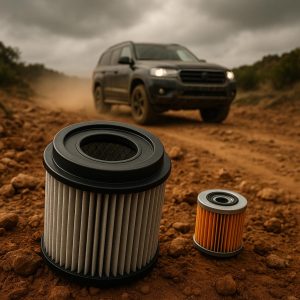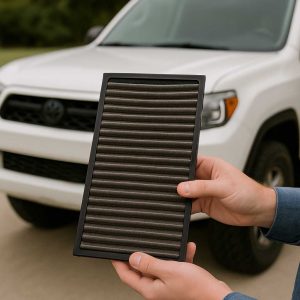When vehicles venture beyond paved roads into dusty trails, muddy terrains, or freezing landscapes, the demands on their components multiply — especially on car filters. Whether you’re driving through sand dunes, rocky trails, or snow-covered tracks, your vehicle’s filters are your first line of defense against contaminants that can damage critical systems.
In off-road and harsh driving conditions, standard filter performance may not be enough. Understanding the role of air, fuel, oil, and cabin filters under extreme stress is crucial for engine health, performance, and longevity.

Why Filters Matter More Off-Road
Car filters in tough environments face increased exposure to:
-
Dust and sand
-
Mud and water
-
Salt and road grime
-
Temperature extremes
In these conditions, clogged or poorly functioning filters can lead to reduced airflow, contaminated fuel or oil, and a compromised cabin environment.
Key Filters and Their Off-Road Roles
1. Air Filter: The Engine’s First Defense
Purpose: Prevents dust, sand, and debris from entering the combustion chamber.
Off-Road Challenge: Off-road air is often filled with large particles. A clogged air filter reduces oxygen supply, causing power loss and increased fuel consumption.
Best Practice: Use high-capacity or dual-stage air filters for better dust retention.
| Condition | Impact on Air Filter | Solution |
|---|---|---|
| Dry, dusty roads | Clogs faster | Use oiled foam pre-filters or high-flow filters |
| Muddy terrain | Moisture + debris | Clean filter more frequently |
| Snow/salt roads | Corrosion risk | Use filters with rust-resistant housings |
2. Fuel Filter: Clean Fuel for Smooth Power
Purpose: Removes dirt, rust, and water from fuel before it reaches the engine.
Off-Road Challenge: Fuel contamination risk is higher in remote or low-quality fuel stations common in rugged areas.
Best Practice: Install water-separating fuel filters for off-road or overland travel.
Signs of a Struggling Fuel Filter:
-
Engine hesitation
-
Hard starts
-
Drop in power under load
3. Oil Filter: Protecting Engine Internals
Purpose: Traps metal particles, carbon deposits, and dirt in the oil system.
Off-Road Challenge: Engines under stress from inclines, load, or low-speed torque produce more contaminants.
Best Practice: Use high-efficiency synthetic oil filters, and replace more often during off-road-heavy use.
| Driving Behavior | Filter Stress Level | Recommendation |
|---|---|---|
| Hill climbs | High engine heat | Shorter oil/filter intervals |
| Rock crawling | Low RPM torque | Use premium oil filters |
| Water crossings | Contamination risk | Check oil condition post-trip |
4. Cabin Air Filter: Breathing Clean in Harsh Air
Purpose: Filters outside air before it enters the cabin.
Off-Road Challenge: Dust, pollen, and exhaust fumes are more intense in the wilderness.
Best Practice: Use HEPA or carbon cabin filters to trap ultra-fine particles and neutralize odors.
Harsh Driving Conditions That Demand Stronger Filters
| Environment | Typical Hazards | Filter Impact |
|---|---|---|
| Desert trails | Sand, heat | Air & oil filters clog faster |
| Forest trails | Moisture, pollen | Cabin and air filter stress |
| Snow roads | Salt, icy debris | Corrosion risk on filter housings |
| Urban off-roading | Soot, road grime | Fuel and cabin filter overload |
Off-Road Maintenance Checklist
To ensure reliable performance, inspect and replace filters more often than in standard conditions. Here’s a basic maintenance guide:
| Filter Type | Standard Interval | Off-Road Interval |
|---|---|---|
| Engine air filter | 15,000–20,000 km | 7,000–10,000 km |
| Fuel filter | 30,000–40,000 km | 20,000 km or less |
| Oil filter | Every oil change | Every oil change (5,000–7,000 km) |
| Cabin filter | 20,000 km | 10,000 km or sooner |
Tips for Filter Performance in Extreme Conditions
-
Pre-clean air filters after every off-road trip.
-
Use synthetic oils to reduce deposits in the oil filter.
-
Add fuel additives to help the fuel filter handle poor-quality fuel.
-
Replace rubber filter seals regularly if exposed to mud or high heat.
-
Carry spare filters when overlanding or exploring remote regions.
When to Upgrade Your Filters

Consider upgraded or performance filters when:
-
You frequently drive on unpaved roads.
-
You tow trailers or off-road in mountainous areas.
-
You’re preparing for overland trips or expeditions.
-
You notice performance drops even with clean filters.
Examples of Upgraded Filter Options:
-
Washable performance air filters
-
Steel-canister high-capacity oil filters
-
Dual-layer synthetic fuel filters
-
Activated carbon cabin filters
Protect Your Engine — Choose the Right Filters
Using high-quality, vehicle-specific filters is essential in harsh conditions. Standard filters may not withstand the physical and environmental stress of rugged driving.
Better protection
Improved engine performance
Longer service intervals (with proper filter choice)
Buy Car Filters online — Find off-road ready air, oil, fuel, and cabin filters from top brands tailored to your driving needs.
Final Thoughts
In challenging environments, your car’s filters are the unsung heroes. From battling sandstorms to filtering dirty fuel in the wilderness, they keep your engine breathing clean and your ride smooth. But filters wear out faster in harsh conditions — so proactive inspection, frequent replacement, and using the right filter type make a world of difference.
Whether you’re a weekend off-roader or a full-time overlander, never underestimate the role of car filters. Prepare your vehicle — and your adventure — with filters built to handle the wild.